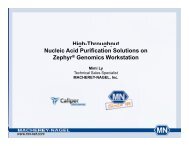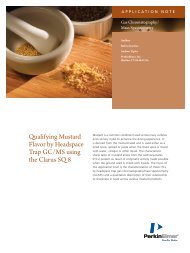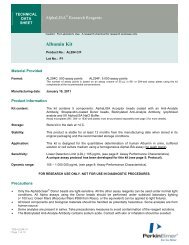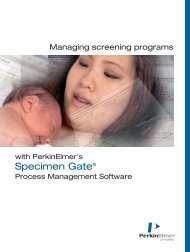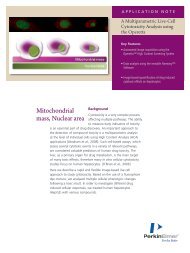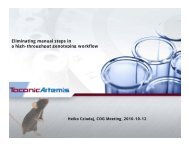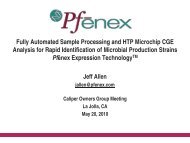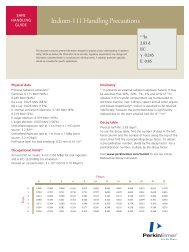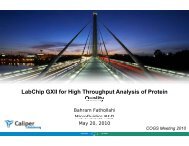AlphaScreen⢠MAP Kinase Assay - PerkinElmer
AlphaScreen⢠MAP Kinase Assay - PerkinElmer
AlphaScreen⢠MAP Kinase Assay - PerkinElmer
Create successful ePaper yourself
Turn your PDF publications into a flip-book with our unique Google optimized e-Paper software.
Application Note<br />
<strong>MAP</strong> <strong>Kinase</strong> <strong>Assay</strong><br />
ALPHASCREEN APPLICATION NOTE ASC-013<br />
www.perkinelmer.com
Introduction<br />
AlphaScreen <strong>MAP</strong> <strong>Kinase</strong> <strong>Assay</strong> was designed to measure ERK1/2 <strong>MAP</strong> kinase activity present<br />
in purified enzyme preparations or in cell extracts. The assay was developed using a very active<br />
ERK1 preparation (soluble cell extract prepared from insect cells infected with Raf1/MEK1/ERK1)<br />
made at <strong>PerkinElmer</strong>. However, it can easily be applied to ERK1 extracted from other sources and<br />
to other <strong>MAP</strong> kinases.<br />
Mitogene-activated protein kinases (<strong>MAP</strong>Ks) represent important targets for the development of<br />
therapeutic agents for a wide spectrum of diseases, including neurodegenerative disorders,<br />
inflammation, cancer and septic shock. Mammalian <strong>MAP</strong>K signaling cascades regulate important<br />
processes, including gene expression, cell proliferation, cell motility as well as cell survival and<br />
death. All cascades include a <strong>MAP</strong>K, <strong>MAP</strong>K kinase (<strong>MAP</strong>KK, MEK or MKK) and a <strong>MAP</strong>KK kinase<br />
(<strong>MAP</strong>KKK or MEKK). The archetype and best characterized of these cascades is the one leading<br />
to activation of ERK1 and ERK2, also known as p44mapk and p42mapk, respectively.<br />
Principles of AlphaScreen Technology<br />
AlphaScreen is a bead based non-radioactive Amplified Luminescent Proximity Homogeneous<br />
<strong>Assay</strong>. When a biological interaction brings the beads together, a cascade of chemical reactions act<br />
to produce a greatly amplified signal. On laser excitation, a photosensitizer in the “Donor” bead<br />
converts ambient oxygen to a more excited singlet state. The singlet state oxygen molecules diffuse<br />
across to react with a thioxene derivative in the Acceptor bead, generating chemiluminescence<br />
at 370 nm that further activates fluorophores contained in the same bead. The fluorophores<br />
subsequently emit light at 520-620 nm.<br />
In the absence of a specific biological interaction, the singlet state oxygen molecules produced by<br />
the Donor bead go undetected without the close proximity of the Acceptor bead. As a result, only<br />
a very low background signal is produced.<br />
AlphaScreen provides a highly versatile, sensitive, homogeneous and miniaturizable means to<br />
efficiently perform assay development and HTS resulting in higher throughput at lower costs.<br />
To maximize AlphaScreen signal detection, the AlphaQuest ® HTS Microplate Analyzer and<br />
Fusion-Alpha Multilabel Reader were developed with the capability to measure assays in multi-well<br />
plates. These instruments use a highly efficient laser diode emitting at 680 nm, fiber optics and<br />
specially optimized photomultiplier tubes. For further details on AlphaScreen technology, refer to:<br />
A Practical Guide to Working with AlphaScreen (reference no. S4077).<br />
AlphaScreen <strong>MAP</strong> <strong>Kinase</strong> <strong>Assay</strong><br />
The AlphaScreen Protein A assay kit was used to measure the activity of ERK1 <strong>MAP</strong> kinase present<br />
in an insect cell extract. In this assay, active ERK1 kinase phosphorylates a synthetic biotinylated<br />
peptide substrate derived from myelin basic protein (MBP). The resulting phosphorylated peptide<br />
is bound by streptavidin-coated Donor beads and by specific anti-phospho-MBP P12 monoclonal<br />
antibody bound to Protein A-conjugated Acceptor beads as shown in Figure 1. The Protein A<br />
approach presented here allows for substitution with a wide range of <strong>MAP</strong> kinase substrate/<br />
antibody pairs.<br />
2
Materials and Methods<br />
The AlphaScreen Protein A <strong>Assay</strong> Kit (catalog number 6760617C) is composed of Donor-<br />
Streptavidin and Acceptor-Protein A beads.<br />
ERK1 cell extract was prepared from insect cells infected with Raf1/MEK1/ERK1, synthetic<br />
biotinylated MBP-derived peptide (FFKNIVTPRTPPPSQGK) was from AnaSpec Inc., and<br />
anti-phospho-MBP antibody was purchased from Upstate Biotechnology Inc. (catalog no. 05-429).<br />
The kinase buffer was composed of 8 mM Hepes (pH 7.4), 4 mM MgCl2, 0.25 mM DTT. The detection<br />
buffer (2.5X concentrated) contained 100 mM Hepes (pH 7.4), 100 mM EDTA and 0.25 % BSA.<br />
The AlphaScreen <strong>MAP</strong> kinase assay involves the following three steps:<br />
1. Mix ERK1 <strong>MAP</strong> kinase, biotinylated MBP-derivedpeptide substrate and ATP in a well of a<br />
384-well plate: (ex.: <strong>PerkinElmer</strong> OptiPlate 384 well plates cat. No. 6007290 and 6007299);<br />
incubate for 30 minutes at room temperature (RT).<br />
2. Quench by adding detection buffer containing EDTA, Donor-Streptavidin and Acceptor-Protein<br />
A beads/anti-phospho-MBP antibody mixture; incubate for 1 hour at RT.<br />
3. Detect AlphaScreen signal using an AlphaQuest HTS Microplate Analyzer or a Fusion-Alpha<br />
Multilabel Reader.<br />
Emission<br />
520-620 nm<br />
Excitation<br />
680 nm<br />
Streptavidin-coated<br />
AlphaScreen Donor Beads<br />
Biotinylated phosphorylated<br />
MBP peptide<br />
Protein A-conjugated<br />
AlphaScreen Acceptor Beads<br />
Anti-phospho MBP antibody<br />
Figure 1. Phosphorylated polypeptide bound by streptavidin-coated Donor beads and by specific anti-phospho-MBP<br />
antibodies bound to Protein A-conjugated Acceptor beads.<br />
3
Materials and Methods (continued)<br />
All assays were performed in white, opaque 384-well plates (ex.: <strong>PerkinElmer</strong> OptiPlate 384 well<br />
plates cat. No. 6007290 and 6007299) in a final volume of 25 µL using 5 µL ERK1 extract, 10 µL<br />
biotin-peptide/ATP mix and 10 µL detection mix. For inhibition experiments, ERK1 extract was<br />
pre-incubated with 5 µL staurosporine for 15 minutes prior to adding 5 µL biotin-peptide/ATP<br />
mix. Anti-phospho-MBP antibody was used at 1 nM, and Donor-Streptavidin and Acceptor-Protein<br />
A beads were used at 20 µg/mL each.<br />
Figure 2. Titration of Enzyme and Substrate.<br />
Results<br />
Titration of Enzyme and Substrate For assay sensitivity and linearity, substrate should be used at<br />
a concentration equal to or below its Km, and the quantity of enzyme should be as low as possible<br />
while maintaining a good S/B ratio.<br />
The optimal amount of ERK1 extract and optimal concentrations of peptide substrate have been<br />
determined by titration of each component in the kinase assay. The apparent Km values for MBP<br />
peptide substrate were 4.8, 4.4, 1.5 and 0.9 µM for total protein quantities of 0.25, 0.5, 1.0 and<br />
2.0 µg/ well, respectively. As shown in Figure 2, a maximal substrate concentration of 1 µM<br />
and 1 µg or less of total protein in cell extract must be used to meet the assay requirements.<br />
ATP Titration<br />
The Km for ATP, measured for the kinase reaction at 0.5 µM peptide substrate using 1 µg of ERK1<br />
extract, was determined to be 94 µM (Figure 3). Optimal ATP concentration should range between<br />
10 and 100 µM to run the assay near or below the Km while maintaining a good signal-to-background<br />
ratio.<br />
4
Time Course of ERK1 Phosphorylation<br />
A time course experiment was performed using different enzyme quantities to assess the linearity<br />
of the assay. As shown in Figure 4, a quantity of ERK1 extract as low as 0.25 µg showed a<br />
linear response over 70 minutes and generated AlphaScreen counts of 55,000 after 60 minutes,<br />
corresponding to a S/B ratio of 85 (background = signal obtained in absence of enzyme). At 0.5 µg<br />
and 1 µg of ERK1 extract, activity was linear over 40 and 30 minutes, respectively. One µg of<br />
enzyme resulted in a S/B ratio of 40 after a 30-minute incubation at room temperature. These<br />
conditions were used as standard conditions for subsequent experiments.<br />
A lag phase was observed within the first minutes, which can be attributed to either the low<br />
amount of product formed during this period (below the affinity of the antibody for this product),<br />
the slow ATP binding or the fact that the enzyme was not purified.<br />
Inhibition by Staurosporine<br />
Staurosporine, a general kinase inhibitor, was tested against ERK1 at two ATP concentrations, 25<br />
and 50 µM. The IC50 value at 50 µM of ATP was determined to be 150 nM. This value was<br />
reduced by half (71 nM) when ATP concentration was decreased proportionally, as expected with<br />
a competitive inhibition by staurosporine (Figure 5).<br />
Figure 3. ATP Titration. Figure 4. Time Course of ERK1 Phosphorylation.<br />
Figure 5.<br />
Staurosporine Inhibition.<br />
5
Conclusion<br />
AlphaScreen <strong>MAP</strong> <strong>Kinase</strong> assay is a homogenous, miniaturized and fully automatable nonradioactive<br />
screening assay for ERK1 <strong>MAP</strong> <strong>Kinase</strong>. The assay was proven to be very sensitive and<br />
reproducible in detecting phosphorylated substrates. Due to the versatility of the AlphaScreen<br />
Protein A-bound Acceptor beads used, the assay could be applied to any other <strong>MAP</strong> kinases,<br />
purified or present in soluble cell extracts, for which specific <strong>MAP</strong> <strong>Kinase</strong> substrates and antibodies<br />
are available.<br />
<strong>PerkinElmer</strong> Life and Analytical Sciences, 710 Bridgeport Avenue, Shelton, CT 06484 USA (800) 762-4000 or (+1) 203-925-4602<br />
<strong>PerkinElmer</strong> Life and Analytical Sciences, Imperiastraat 8, BE-1930 Zaventem Belgium<br />
Technical Support: in Europe: techsupport.europe@perkinelmer.com in US and Rest of World: techsupport@perkinelmer.com<br />
Belgium: Tel: 0800 94 540 • France: Tel: 0800 90 77 62 • Netherlands: Tel: 0800 02 23 042 • Germany: Tel: 0800 1 81 00 32 • United Kingdom: Tel: 0800 89 60 46<br />
Switzerland: Tel: 0800 55 50 27 • Italy: Tel: 800 79 03 10 • Sweden: Tel: 020 79 07 35 • Norway: Tel: 800 11 947 • Denmark: Tel: 80 88 3477 • Spain: Tel: 900 973 255<br />
© 2003 <strong>PerkinElmer</strong>, Inc. All rights reserved. <strong>PerkinElmer</strong> and AlphaScreen are registered trademarks of <strong>PerkinElmer</strong>, Inc. AlphaQuest, OptiPlate and Fusion are trademarks or registered trademarks of <strong>PerkinElmer</strong>, Inc.<br />
AlphaScreen chemistry is based on patented LOCI ® technology developed by Dade Behring, Inc. <strong>PerkinElmer</strong> holds the exclusive license for this technology in the life science research market. The names of actual companies<br />
and products mentioned herein may be trademarks or registered trademarks of their respective owners. <strong>PerkinElmer</strong> reserves the right to change this brochure at any time without notice and disclaims liability for editorial,<br />
pictorial, or typographical errors. Printed in USA. 006818 [K4707(K4707-00) 7/01]<br />
www.perkinelmer.com



